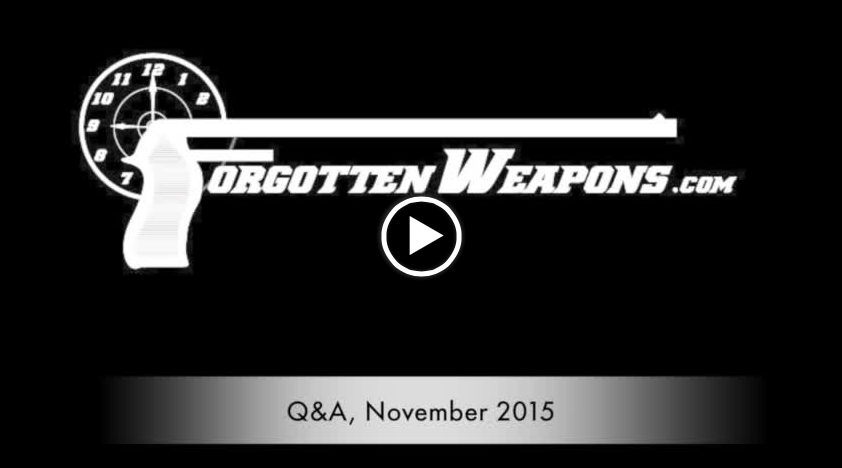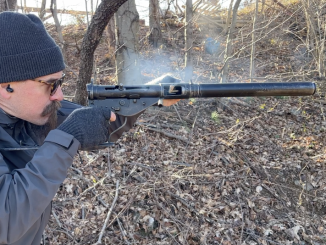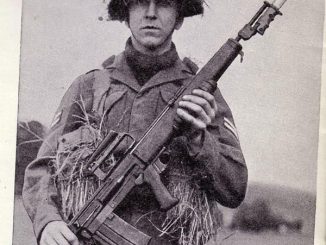This rifle sold for $17,250 at Rock Island on December 1, 2018.
The British started World War One without a sniper program, but were quick to develop one once faced with the threat of well-trained German snipers. The initial equipment used by the British was a motley collection of commercial hunting rifles, but by 1915 the government was issuing contract to mount mostly 3x and 4x telescopes on SMLE and Pattern 1914 rifles. About 10,000 scoped sniper rifles were issued in total during the war using a variety of scopes and mount types (a standardized pattern would not be adopted until 1918). The example we have here today is the most common type; an SMLE with an offset Periscopic Prism Company scope using a 5-screw mount assembled by the same company. Later in the war the offset mounts would slowly fall out of favor to the center-mounted scopes, which allowed better shooting at the cost of being able to use stripper clips.




Osprey Publishing’s ‘Out of Nowhere A HISTORY OF THE MILITARY SNIPER’ (link below) is simply the best book on the subject of sniping; apart from, maybe, how to train to become one. You can find things about WW1 sniping on-line, but I cannot find anything which includes background or development. It all seems to be about the effect.
Basically the German Armies recruited gamekeepers who already knew how to hide and shoot nervous prey. The British woke up to the fact this kind of killing of high value targets for little loss would be useful, and developed the modern sniper concept. Good shots could volunteer, and would be properly trained in both shooting and fieldcraft, and working in pairs, with one spotting and one shooting.
https://ospreypublishing.com/out-of-nowhere-pb
Eventually, the British decided to be a bit unsporting in their counter-sniping by bringing in 62 large-caliber sporting rifles (all capable of killing bull elephants at a safe distance). The Germans soon learned that their sniper shields were easily penetrated by .475 No 2 Nitro Express and .577 Nitro Express. I’m surprised that the Germans DIDN’T respond by issuing their snipers with big-game sporting rifles.
Interestingly there existed Pattern 13 rifle variant for .470 Nitro Express, see 1st photo from bottom: https://sites.google.com/site/britmilammo/express-rifles
“Germans DIDN’T respond by issuing their snipers with big-game sporting rifles.”
Did not they developed SmK bullet for 7,9×57 in response?
The K bullets were intended for use against light tank armor. British snipers didn’t use armor plates, right?
So if there were not targets to engage, why they have to bother with introduction of “issuing their snipers with big-game sporting rifles.”?
@Daweo
Admittedly, standard rifle ammunition kills well enough. The introduction of British tanks is what spurred German anti-armor munitions in the first place. By then, it was too late for the Germans to think about getting their big game rifles, since the armor plating on the tanks was probably much thicker than the shield plates that German snipers used.
Interestingly, the French tried issuing shields to trench raiding units. The shields were heavy and impractical for riflemen, so anyone with a shield was likely the guy with a bag of nasty grenades (the Frenchman would be same from grenade explosions but his victim would get shredded).
You might try “Sniping in the Great War” by Martin Pegler (Pen and Sword is the publisher).
(That was meant as a reply for the first comment by “G”, but it seems everyone is commenting at once so it ended up further down the list.)
Sounds like you need to read about the Lovat scouts – from Boer war on Scottish gamekeepers (also called Gillies). Lord Lovat (contributed to Founding commandos was a cousin of Stirling. (Founding SAS)
One would think that for snipers it would be OK to actually issue a couple of spare magazines so they needn’t use stripper slips nor single-load.
You’d probably have to requisition spare magazines, as those were freakishly expensive to craft at the time. Changing the magazines for bolt-action rifles back then was not by any means easy. For both the Lee-Enfield and the Schmidt-Rubin, removing the magazine was actually a time-consuming process as the magazines were NOT intended for rapid change. It doesn’t help that the magazines were NOT considered disposable. The process could take up to thirty seconds in dirty field conditions(assuming you were taking the spare magazine out of a pouch and replacing it with the empty magazine). That’s way slower than using the stripper clips. Ergo, for snipers, here’s a hint: MAKE EVERY SHOT COUNT.
Then there’s also Herbert W. McBride’s “A Rifleman Went to War”.
Gun owning social classes in Britain were not generally used to rifles, and especially not to scope sighted rifles.
They’d have driven bird shoots on their leave days, and the game keepers /ghillies were most likely employed as his lordship’s batman or driver, rather than using his field craft.
Lovatt’s Scouts. Literally a private army of highland ghillies, skilled with rifles, field craft and (spotting) telescopes, first raised during the second south African war, was used (perhaps deliberately!) in as inappropriate settings as possible. Including the Gallipoli beachhead.
By contrast, German and Austrian gun owners were more familiar with scoped rifles and their use.
There’s also a big difference in philosophy
When the German advance on the Western front was halted, the troops retreat Edinburgh from the floodplains of the Summer, the Maar etc, and dug trenches on the free draining, chalk, valley sides. Overlooking the flood plains.
British generals denied the existence of a “no man’s land” there was only land that hadn’t been occupied yet
So British forces were digging trenches in the poorly drained sloppy clay ground of the valley bottoms
And the trenches had to be neat and tidy, no rubbish lying around like the trenches of those scruffy Huns. Even a mouse could be easily noticed on the neat and regular rows of sandbags.
I gather that there was great resistance to admitting that the regular appearances of corpses,cleanly shot through the head or throat, was not the result of “a stray bullet”
It was the result of highly skilled snipers
Incidentally, a snipe is a very tricky bird to shoot. It is small, fast and it swerves as it flies away
Hence the name “sniper”, for someone who takes difficult shots.
The early pioneers of British sniping were not popular. They often disobeyed orders, to sneak out and create cover in no man’s land, that they might use weeks or months later
They were seen as unsporting trouble makers, who would bring down retribution on a whole area by artillery barrage.
It is a wonder that sniping ever became an even semi official practice on the western side of the lines.
And yeah, offset scopes! Hardly ideal for firing from a loophole.
On the subject of optics
Specialisation in the division of labour, had resulted in an even wider gap developing between the optic’s produced in Germany, Austria and Switzerland, compared to the optics produced outside of those countries by the late 1930s
Leica, Ziess, Wild, Swarorvski etc had virtually no equivalents outside of the German speaking countries.
At the start of the war to make a world safe for Stalin…
There wasn’t even a source of sand in Britain that was suitable for making optical glass for submarine periscopes or any other high quality optics.
The British admiralty (biggest navy in the world at that time) had to send people out to look for suitable sand!
Except Japan, where the company now known as Nikon, but then called Nippon Kōgaku K.K. had been established in 1917 and by the 1930s was already making world class optics. They made a lot of optics for military use and especially for the IJN, although that is now unlikely to get a mention in official Nikon histories. Nikon optics back then were perhaps not quite up to the best the Germans could manage, but they were very close.
Nikon, like everybody else outside Germany, of course still did not have the relatively inexpensive method of making coated optics which had been developed by Zeiss in the 1930s. It enabled for the first time mass production of coated optical lenses for high volume products such as field glasses (binoculars) and rifle scopes. It was kept as a military secret until 1940. Typical to early WW2 German practices, Zeiss started to make coated lens elements for civilian products almost immediately when allowed despite the war going on (same were admittedly dual-purpose). Still, due to demands of military production, most of them were not assembled to finished products until after the war. Many Zeiss camera and binocular lenses made from 1946 to 1950 actually have lens elements made during the war.
Germany was equally short of rubber. Britain and Germany traded rubber for optics throughout the war, I think.
http://greatwarproject.org/2015/07/20/a-clear-case-of-trading-with-the-enemy/
“Gun owning social classes in Britain were not generally used to rifles, and especially not to scope sighted rifles.”
What about France?
Retreated from the somme, Maar etc
Damn the auto incorrect
Ps
A good friend spent a lot of time working with a surviving lovatt scout, from the war to make a world safe for Stalin, Mao, Tito, pol pot…
The lovatt’s Scouts were used in some roles more suited to their exceptional skills in that war, and a lot of roles completely unsuited to them.
The guy was absolutely screwed up by his experiences.
He seemed to have a lot more memories of using hand grenades and a dagger than he did a rifle. But that may just have been the way his memory worked.
Hi Keith, I wrote a note to Ian regarding my agreement to mutual e-mail addresses exchange. So far there was no response.
Robert Graves wrote that, in a crack regiment like the Royal Welsh Fusiliers, officers with shooting skills went sniper-hunting to keep their trench lines relatively sniper-free. He seemed to think that the Army as a whole failed to address the issue systematically.
This is just me remembering from reading ‘Goodbye to All That’ many years ago.
I am little surprised hearing about “fairness” concerns when comes to sniping. Someone had to start it, so the other side had more justification to respond alike. It does not make war any dirtier than it is.
Prompted by this feature I looked back at A-H M95 carbine (my grandpa used to call it “Stutz”) with scope. Their scopes look and work, alike.
Here’s the book from the man who started and ran the British sniper program-
https://babel.hathitrust.org/cgi/pt?id=uc1.$b42510;view=1up;seq=11
The United States made plenty of first class optics in the late 19th/early 20th centuries, and they were generally in surveying instruments- the parents of optical rifle sights. Those windage adjustment screws look just like the ones on an old Gurley transit or Buff & Buff level.